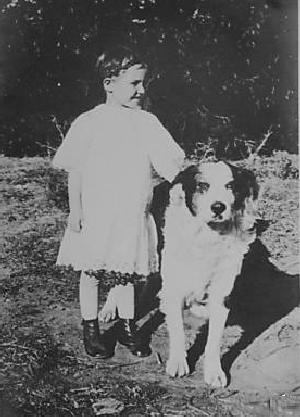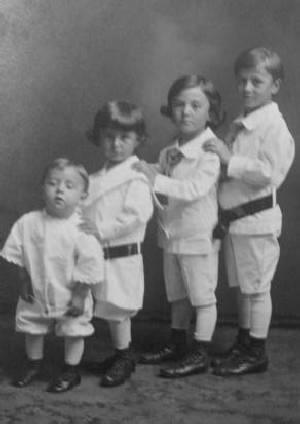
American Boy Skirted Garments: Chronology--The 20th Century

Figure 1.-- American boys still wore skirted garments in the early 20th century. The fashion for the most part had declined significantly. Especially after the early-1900s we see far fewer boys wearing dresses and kilt suits. We still see a few boys wearing dresses, but they tended to be very young boys and the desses were commonly plain. This snapshot was probably taken in the 1900s. The unidntified boy looks to be about 3 years pld.
|
|
Boys still wore skirted garments in the early 20th century. The fashion for the most psrt had declined significantly.
Especially after the early-1900s we see far fewer boys wearing dresses and kilt suits. There was on exception to this, the tunic suit. In fact, the tunic became a very popular boys' garment in both the 1900s ad 10s. At the turn of the 20th century, tunic suits was a major style for boys. Some girls wore them are dresses styled rather like a tunic stuit, but they were much more popular for girls. The popularity of other skirted garments, especially dresses and kilt suits, declined very sharply, especially after about 1905. We see the shift in both catalogs and the photographic record. We saw this decline in the 1890s, but it was especially notablle by the late-1900s. We still see some younger boys wearing dresses, but after World War I (1914-18), the once very popular covention rapidly disappesard as a major fashion. Boys wearing skirted garments rapidly wentout of style. And in the 1920s, tunic suits also disappeared. We only rarely see boys wearing skirted garments after the 30s. It has dissapppeared to the extent that we notice some sellers handling old photographs are agast that boys were ever dressed in skirted garments. The only skirted garmets we see boys wearing after World War II (1939-45) are those boys participating in ethnic (Greek, Irish, and Scottish) events. And even boys doing Irish dancing stopped wearing kilts in the 1990s when River Dance with boys wearing long black pants became popular.
American boys still wore skirted garments in the early-20th century, but to a much more limited extent. The fashion for the most part had declined significantly, a trend which began kin the late-1890s. Especially after the early-1900s we see far fewer boys wearing dresses and kilt suits. And even in the eary-1900s, the boys we do see wearing skirted garments were just the very youngest boys. We no longer se mny older pre-chool boys wearing skirted garments like they did in the 19th century. We still see a few boys wearing dresses, but they tended to be very young boys. Rarely do w even see 3-year ols abd virtually never 4-year olds wearing dresses. And the dresses were commonly plain, not the fancy dresses we might see in the 19th century. And we e far fewer skirts and kilts, especualy by mid-decade. There was on exception to this declining use of skirted garments--the tunic suit. In fact, the tunic became a very popular boys' garment in both the 1900s and 10s. unics were worn thriughout the 19th century, but had declined in the 1880s. At the turn-of-the 20th century, however, tunic suits became was a major style for boys. Some girls wore them are dresses styled rather like a tunic stuit, but they were much more popular for boys. The popularity of all other skirted garments, especially dresses and kilt suits, declined very sharply, especially after about 1905. This was the exact oposite for tunics. We see the shift in catalogs which were increasing in number, detail, and coverage and have the advantage of being dated. It is also very notable in the photographic record. We saw this decline notably beginning in the 1890s, but it was especially notablle by the late 1900s. We do not understand just why this shift in clothing conventiins occurred, but it it is very notable.

Figure 2.-- American boys continued wearing tunic suits in the 1910s when other skirted garments were disappearing. Here the whole family is done upm in tunic suits. The older boy is school age.
|
|
The major trends at work in the 1900s played out in the 1910s. Dresses for boys became much less common, although we still see some, mostly very young boys wearing them. Kilt suits disappeared completely, but we still occassonally see little boys wearing very plain dresses, This development is notable in both catalogs and the photographic record. The tunic suit became popular at the turn-of-the 20th century. We continue to see boys wearing tunic suits in the 1910s. We see some variation in styling with some older boys wearing shorter-length tunics well above their knees. They were done in various colors, but white tunics are very common in the photograpohic record. Here home sewing may have been a factor. The tunic worn with bloomer knickers were a very flexible garment. There were worn both for play and when dressing up. Some younger boys even wore them to school. We see pants becoming increasingly important for younger boys. Most school-age boys wore knickers. And unlike dresses and kilts, tunic suits were worn with bloomer knickers. Most were bloused above the knee, but some were worn with straight-leg knee pants as well. All of these trends can be observed in both catalogs and the photogrphic record.
The 1920s
We still see a few younger boys wearing dresses, primarily infants and early todlers, After World War I (1914-18), the once very popular covention rapidly disappesard as a major fashion. Boys wearing skirted garments simply went out of style. And in the 1920s, tunic suits, the one remaining importnt skirted garments, also disappeared. We see some tunic suits in the very early-1920s, but they were less common and the tuniv was notably shorter, mot longer cobering the knee pants or bloomer knickrs. They were more like jackets. Younger American boys wore short pants and most schoo-age boys knickers. Older boys might wear long pants. But skirted garments for all but infants virtually disappeared. This is all apparent in catalogs and the potographic record.
The 1940s
We only rarely see boys wearing skirted garments after the 30s. It has dissapppeared to the extent that we notice some sellers handling old photographs are agast that boys were ever dressed in skirted garments.
The 1960s
The only skirted garmets we see boys wearing after World War II (1939-45) are those boys participating in ethnic (Greek, Irish, and Scottish) events.
br>
The 1990s
And even boys doing Irish dancing stopped wearing kilts in the 1990s when River Dance with boys wearing long black pants became popular.
HBC

Navigate the Historic Boys' Clothing Web dress pages:
[Return to the Main U.S. skirted garments chronology page]
[Return to the Main U.S. skirted garments page]
[Return to the Main U.S. garment page]
[Pinafores]
[Ringlet curls]
[Smocks]
[Bodice kilts]
[Kilts]
[Fauntleroy dresses]
[Sailor dresses]
[Fancy dresses]
[Dresses: 16th-18th centuries]
[Dresses: Early-Mid-19th century]
[Dresses: Late-19th century]
[Dresses: Early 20th century]
[Difficult images]
[Movie dresses]
Navigate the Boys' Historical Clothing Web Site:
[Introduction]
[Activities]
[Biographies]
[Chronology]
[Clothing styles]
[Countries]
[Bibliographies]
[Contributions]
[Essays]
[FAQs]
[Glossaries]
[Images]
[Links]
[Registration]
[Tools]
[Boys' Clothing Home]
Created: 5:56 PM 2/11/2010
Last updated: 9:18 PM 10/16/2014




